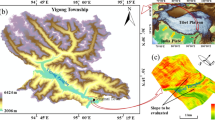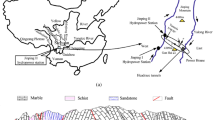Abstract
The existing structural discontinuities such as faults, joints and cleavages in rock slopes control the rock mass properties. The presence of structural discontinuities is strongly influenced by the regional tectonic structures. The concept of damage as applied to intact rock and rock mass relates to the degradation of their strength properties. The high variability in fracture intensity and trace length has been found as one move away from the hinge zone due to damage caused by regional syncline in Garhwal Himalaya. The high in situ stresses in fold hinge zone during folding propagated the fractures utmost and result in a high frequency of mean-sized fractures. The high fracture intensity and nearly equal joint traces intersected comparatively smaller-sized blocks. Whereas the rock mass away from the damage zone (fold core) at sites 2 and 3 comprises low fracture intensity and intersects relatively larger-sized blocks. Deterministic and stochastic DFN approaches were implemented in 3DEC to model the rock mass conditions within and away from damage zone. The study provided a comprehensive insight into rock mass behavior using structural investigation and numerical modeling. The work concluded that the high fracture intensity in fold hinge zone reduced the rock mass strength, providing the kinematic freedom to blocks resulting in slope failure.
























Similar content being viewed by others
References
Barton N, Bandis S (1990) Review of predictive capabilities of JRCJCS model in engineering practice. Int: Proc. Symp. on Rock Joints, Loan, Norway, pp 603–610.
Barton N, Choubey V (1977) The shear strength of rock joints in theory and practice. Rock Mech 10:1–54. https://doi.org/10.1007/BF01261801
Bonilla-Sierra V, Scholtès L, Donzé F, Elmouttie M (2015) DEM analysis of rock bridges and the contribution to rock slope stability in the case of translational sliding failures. Int J Rock Mech Min Sci 80:67–78
Brideau MA (2005) The Influence of tectonic structures on rock mass quality and implications for rock slope stability. MSc Thesis. Simon Fraser University, Canada.
Brideau MA, Yan M, Stead D (2009) The role of tectonic damage and brittle rock fracture in the development of large rock slope failures. Geomorphology 103:30–49
Brideau M, Pedrazzini A, Stead D (2011) Three-dimensional slope stability analysis of South Peak, Crowsnest Pass, Alberta, Canada. Landslides 8:139–158
Brideau MA, Stead D (2012) Evaluating kinematic controls on planar translational slope failure mechanisms using three-dimensional distinct element modeling. Geotech Geol Eng 30:991–1011
Brideau MA, McDougall S, Stead D, Evans SG, Couture R, Turner K (2012) Three-dimensional distinct element modeling and dynamic analysis of a landslide in gneissic rock, British Columbia, Canada. Bull Eng Geol Environ 71:467–486
Budetta P, Nappi M (2011) Heterogeneous rock mass classification by means of the geological strength index: the San Mauro formation (Cilento, Italy). Bull Eng Geol Environ 70:585–593
Chester FM, Logan JM (1986) Composite planar fabric of gouge from the Punchbowl Fault, California. J Struct Geol 9:621–634
Coggan JS, Pine RJ (1996) Application of distinct-element modeling to assess slope stability at Delabole slate quarry, Cornwall, England. Trans Inst Min Metall 105:22–30
Costa M, Coggan JS, Eyre JM (1999) Numerical modeling of slope behaviour of Delabole slate quarry (Cornwall, UK). Int J Surf Min Reclam Environ 13(1):11–18
GPL Software (2018) Cloud Compare V.2.9. http://www.cloudcompare.org
Dershowitz WS, Herda HH (1992) Interpretation of fracture spacing and intensity. In: Proc. 33rd U.S. Rock Mech. Symp., Santa Fe, NM
Dershowitz WS, Lee G, Geier J, LaPointe P (2014) FracMan: interactive discrete feature data analysis, geometric modeling and exploration simulation. Golder Associates Inc.
Donati D, Stead D, Brideau MA, Ghirotti M (2017) A model-oriented, remote sensing approach for the derivation of numerical modeling input data: Insights from the Hope Slide, Canada, Proc ISRM Regional Conference., Afrirocks, Cape Town, S.A, pp 15
Dick GJ, Eberhardt E, Stead D, Rose ND (2013) Early detection of impending slope failure in open pit mines using spatial and temporal analysis of real aperture radar measurements. Slope Stability 2013, Australian Centre for Geomechanics, pp 949–962
Elmo D (2006) Evaluation of a hybrid FEM/DEM approach for determination of rock mass strength using a combination of discontinuity mapping and fracture mechanics modelling, with particular emphasis on modelling of jointed pillars. Ph.D. Thesis. Camborne School of Mines, University of Exeter, UK
Elmo D, Clayton C, Rogers S, Beddoes R, Greer S (2011) Numerical simulations of potential rock bridge failure within a naturally fractured rock mass. In: Proc. Int. Symp. on Rock Slope Stability in Open Pit Mining and Civil Engineering. Vancouver, Canada
Elmo D, Stead D (2010) An integrated numerical modelling–discrete fracture network approach applied to the characterisation of rock mass strength of naturally fractured pillars. Rock Mech Rock Eng 43:3–19
Elmo D, Donati D, Stead D (2018) Challenges in the characterisation of intact rock bridges in rock slopes. Eng Geol 245:81–96
Fossen H (2010) Structural Geology. University of Bergen, Cambridge University Press, New York
Francioni M, Stead D, Sciarra N, Calamita F (2018) A new approach for defining slope mass rating in heterogeneous sedimentary rocks using a combined remote sensing-GIS approach, Bull Eng Geol Environ pp 1–22
Francioni M, Simone M, Stead D, Sciarra N, Mataloni G, Calamita FA (2019) New fast and low-cost photogrammetry method for the engineering characterization of rock slopes. Remote Sens 11:1267
Havaej M (2015) Characterisation of high rock slopes using an integrated numerical modeling–remote sensing approach. Ph.D. Thesis. Simon Fraser University, Canada
Havaej M, Coggan J, Stead D, Elmo D (2015) A combined remote sensing–numerical modeling approach to the stability analysis of Delabole Slate Quarry, Cornwall, UK. Rock Mech Rock Eng 178:1–19
Itasca Consulting Group Inc (2017a) 3DEC 5.2, Distinct element modeling of jointed and blocky material in 3D. https://www.itascacg.com/software/3dec
Itasca Consulting Group Inc (2017b) 3DEC 5.2, User’s guide
Johri M (2012) Fault damage zones – observations, dynamic modeling, and implications on fluid flow. Ph.D. Thesis. Stanford University, USA
Mandl G (2005) Rock joints-the mechanical genesis, 2005th edn. Springer, Berlin
Mercer KG (2006) Investigation into the time dependent deformation behaviour and failure mechanisms of supported rock slopes based on the interpretation of observed deformation behaviour. Ph.D. Thesis. University of the Witwatersrand
Pedrazzini A, Jaboyedoff M, Froese CR, Langenberg CW, Moreno F (2011) Structural analysis of turtle mountain: origin and influence of fractures in the development of rock slope failures. Geological Society, London, Special Publications 351:63–183
Pradhan SP, Siddique T (2020) Stability assessment of landslide-prone road cut rock slopes in Himalayan terrain: a finite element method based approach. J Rock Mech Geotech Eng 12:59–73
Pradhan SP, Vishal V, Singh TN (2018) Finite element modelling of landslide prone slopes around Rudraprayag and Agastyamuni in Uttarakhand Himalayan terrain. Nat Hazards 94:181–200
Pradhan SP, Panda SD, Roul AR, Thakur M (2019) Insights into the recent Kotropi landslide of August 2017, India: a geological investigation and slope stability analysis. Landslides 16:1529–1537. https://doi.org/10.1007/s10346-019-01186-8
Price NJ, Cosgrove JW (1990) Analysis of geological structures. Cambrige university press, pp 502
Priet SD, Hundson JA (1976) Discontinuity spacing in rock. Int J Rock Mech Min Sci Geomech 13:135–148
Pine RJ, Coggan JS, Flynn ZN, Elmo D (2006) The development of a new numerical modelling approach for naturally fractured rock masses. Rock Mech Rock Eng 39(5):395–419
Rocscience (2014) c Dips 6.0 graphical and statistical analysis of orientation data. Rocscince Inc., Toronto, Canada
Savage HM, Brodsky EE (2011) Collateral damage: evolution with a displacement of fracture distribution and secondary fault strands in fault damage zones. J Geophys Res-Sol Ea 116(3)
Shaunik D, Singh M (2019) Strength behaviour of a model rock intersected by non-persistent joint. J Rock Mech Geotech Eng 11:1243–1255
Shaunik D, Singh M (2020) Bearing capacity of foundations on rock slopes intersected by non-persistent discontinuity. Int J Min Sci 30(5):669–674
Rogers S, Elmo D, Webb G, Catalan A (2014) Volumetric fracture intensity measurement for improved rock mass characterisation and fragmentation assessment in block caving operations. Rock Mech Rock Eng 48:633–649
Shankar R (1971) Stratigraphy and sedimentation of Tal Formation, Mussoorie syncline, U P. J Paleontol Soc India 16:1–15
Shanker R, Kumar G, Mathur VK, Joshi A (1993) Stratig raphy of the Blaini, Infrakrol, Krol and Tal succession, Krol belt, Lesser Himalaya. Indian J Petrol Geol 2:9–136
Shipton ZK, Cowie PA (2003) A conceptual model for the origin of fault damage zone structures in high-porosity sandstone. J Struct Geol 25:333–344
Singh J, Thakur M (2019) Landslide stability assessment along Panchkula-Morni road, Nahan salient, NW Himalaya. India J Earth Syst Sci 128:148
Singh J, Pradhan SP, Panda SD, Singh M (2019) Abstract: slope stability assessment of Himalayan road cut slope using advanced remote sensing techniques and numerical simulation. American Geophysical Union (AGU) Fall Meeting 2019, abstract #NH51B-0778, San Francisco, USA. Bibcode: 2019AGUFMNH51B0778S
Singh TN, Pradhan SP, Vishal V (2013) Stability of slope in a fire prone opencast mine in Jharia coalfield, India. Arab J Geosci 6:419–427
Smith L, Forster CB, Evans JP (1990) Interaction of fault zones, fluid flow, and heat transfer at the basin scale. Hydrogeology of permeability environments, (S. P. Newman and I. Neretnieks, eds.), International Association of Hydrogeological Sciences selected papers in Hydrogeology 2:41–67
Srivastava RM (2002) Probabilistic discrete fracture network models for the whiteshell research area, Ontario. FSS Canada Consultants Inc, Canada
Stead D, Wolter A (2015) A critical review of rock slope failure mechanisms: the importance of structural geology. J Struct Geol 74:1–23
Sturzenegger M, Stead D (2012) The Palliser Rockslide, Canadian Rocky Mountains: characterization and modeling of a stepped failure surface. Geomorphology 138:145–161
Vazaios I, Vlachopoulos N, Diederichs MS (2017) Integration of Lidar-based structural input and Discrete Fracture Network generation for underground applications. Geotech Geol Eng 35:2227–2251
Vazaios I, Farahmand K, Vlachopoulos N, Diederichs MS (2018) Effects of confinement on rock mass modulus: a synthetic rock mass modelling (SRM) study. J Rock Mech Geotech Eng, pp 436–456.
Valdiya KS (1984) Evolution of the Himalaya. Tectonophysics 105(3):229–248
Vanneschi C, Eyre M, Venn A (2019) Investigation and modeling of direct toppling using a three-dimensional distinct element approach with the incorporation of point cloud geometry. Landslides 16:1453–1465. https://doi.org/10.1007/s10346-019-01192-w
Vishal V, Pradhan SP, Singh TN (2015) An investigation on stability of mine slopes using two dimensional numerical modeling. J Rock Mech Tunnel Tech 21(1):49–56
Viviana BS, Scholtès L, Donzé FV, Elmouttie MK (2015) Rock slope stability analysis using photogrammetric data and DFN–DEM modelling. Acta Geotech 10(4) 497–511. https://doi.org/10.1007/s11440-015-0374-z
Zavodni ZM, Broadbent CD (1980) Slope failure kinematics. Bulletin Canadian Institute of Mining, Canadian Institute of Mining and Metallurgy 73:69–74
Acknowledgements
The authors express their sincere acknowledgments to the Department of Earth Sciences, IIT Roorkee, and IIT Bombay for providing the necessary laboratory and computer facilities. We would like to thank IIT Roorkee and American Geophysical Union (AGU) for providing financial support to present this work at AGU, Fall Meeting 2019, San Francisco, USA. JS extends acknowledgment to the Council of Scientific and Industrial Research (CSIR), Govt. of India for providing SPM fellowship to conduct the PhD research work.
Author information
Authors and Affiliations
Corresponding author
Ethics declarations
Conflict of interest
The authors declare no competing interests.
Rights and permissions
About this article
Cite this article
Singh, J., Pradhan, S.P., Singh, M. et al. Control of structural damage on the rock mass characteristics and its influence on the rock slope stability along National Highway-07, Garhwal Himalaya, India: an ensemble of discrete fracture network (DFN) and distinct element method (DEM). Bull Eng Geol Environ 81, 96 (2022). https://doi.org/10.1007/s10064-022-02575-5
Received:
Accepted:
Published:
DOI: https://doi.org/10.1007/s10064-022-02575-5




